
Amphisbaenia is a group of usually legless squamates, comprising over 180 extant species. Amphisbaenians are characterized by their long bodies, the reduction or loss of the limbs, and rudimentary eyes. As many species have a pink body and scales arranged in rings, they have a superficial resemblance to earthworms. While the genus Bipes retains forelimbs, all other genera are limbless. Although superficially similar to the snakes and blind lizards, recent phylogenetic studies suggest that they are most closely related to the true lizards. Amphisbaenians are widely distributed, occurring in North America, Europe, Africa, South America, Western Asia and the Caribbean. They are not found east of the Caspian Sea. Most species are less than 6 inches (150 mm) long.

Pogonas are a genus of reptiles containing eight lizard species which are often known by the common name bearded dragons. The name "bearded dragon" refers to the "beard" of the dragon, the underside of the throat, which can turn black for a number of reasons, most often as a result of stress. They are a semi-arboreal species, spending significant amounts of time on branches, in bushes, and near human habitation. Pogona species bask on rocks and exposed branches in the mornings and afternoons. They are found throughout much of Australia in a wide range of habitats such as deserts, shrublands and Eucalyptus woodlands.

Lampropholis, the Indo-Australian ground skinks or sunskinks, are a genus of skinks in the lizard subfamily Eugongylinae. The genus Lampropholis was previously found to belong to a clade with the genera Niveoscincus, Leiolopisma and others of the Eugongylus group within Lygosominae. They are found mainly in Indonesia and Australia. For similar skinks see genera Bassiana, Pseudemoia, and Niveoscincus.

Nothofagus, also known as the southern beeches, is a genus of 43 species of trees and shrubs native to the Southern Hemisphere in southern South America and Australasia. The species are ecological dominants in many temperate forests in these regions. Some species are reportedly naturalised in Germany and Great Britain. The genus has a rich fossil record of leaves, cupules, and pollen, with fossils extending into the late Cretaceous period and occurring in Australia, New Zealand, Antarctica, and South America. In the past, they were included in the family Fagaceae, but genetic tests revealed them to be genetically distinct, and they are now included in their own family, the Nothofagaceae.
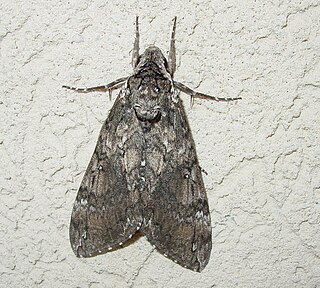
Manduca sexta is a moth of the family Sphingidae present through much of the American continent. The species was first described by Carl Linnaeus in his 1763 Centuria Insectorum.

Waxworms are the caterpillar larvae of wax moths, which belong to the family Pyralidae. Two closely related species are commercially bred – the lesser wax moth and the greater wax moth. They belong to the tribe Galleriini in the snout moth subfamily Galleriinae. Another species whose larvae share that name is the Indian mealmoth, though this species is not available commercially.
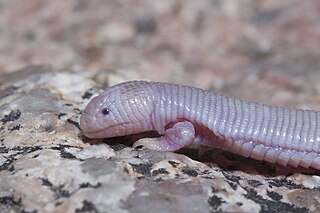
Bipes is a genus of amphisbaenians found only in Mexico, the sole living member of the family Bipedidae. Commonly known as ajolotes, they are carnivorous, burrowing reptiles, but unlike other species of amphisbaenians, they possess two stubby forelimbs placed far forward on the body. The shovel-like limbs are used to scrape away soil while burrowing, in a manner similar to a mole. Evidence for their occurrence in the United States is reviewed by Somma (1993).

Nothofagus moorei, commonly known as Antarctic beech, is an important Gondwana relict of the rainforests of the southern hemisphere. It occurs in wet, fire-free areas at high altitude in eastern Australia.
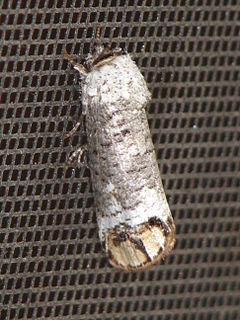
The Cossidae, the cossid millers or carpenter millers, make up a family of mostly large miller moths. This family contains over 110 genera with almost 700 known species, and many more species await description. Carpenter millers are nocturnal Lepidoptera found worldwide, except the Southeast Asian subfamily Ratardinae, which is mostly active during the day.
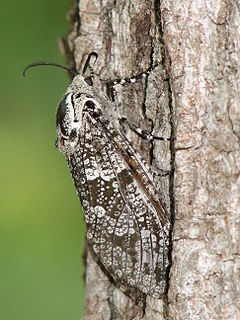
The Cossinae are the nominate subfamily of the Cossidae. The caterpillars of several Cossinae species, such as the carpenterworm and the goat moth, are significant pests. On the other hand, in Chile the caterpillars of the Chilean moth are collected on a commercial scale for sale as fishing bait and terrarium pet food; they are usually called "butterworms" in international trade.

The Iberian worm lizard, Mediterranean worm lizard, or European worm lizard is a species of reptile in the family Blanidae of the clade Amphisbaenia. There are 130 species of amphisbaenians, most found in Spain, Africa, South Africa, and the Caribbean islands. The Iberian worm lizard is locally known as cobra-cega (Portuguese), culebrilla ciega (Spanish), and colobreta cega (Catalan), all meaning "blind snake". Recent studies into the mitochondrial and nuclear genomic data of 47 isolated B. cinereus populations show rather large sequence divergence between two apparent clades, leading some researchers to call for a division of the Iberian worm lizard into two species. While little is known of B. cinereus in comparison with some other reptile species, new insight is growing about this primitive, ancestral reptile.

Worms are many different distantly related animals that typically have a long cylindrical tube-like body, no limbs, and no eyes. Worms vary in size from microscopic to over 1 metre (3.3 ft) in length for marine polychaete worms, 6.7 metres (22 ft) for the African giant earthworm, Microchaetus rappi, and 58 metres (190 ft) for the marine nemertean worm, Lineus longissimus. Various types of worm occupy a small variety of parasitic niches, living inside the bodies of other animals. Free-living worm species do not live on land, but instead, live in marine or freshwater environments, or underground by burrowing. In biology, "worm" refers to an obsolete taxon, vermes, used by Carolus Linnaeus and Jean-Baptiste Lamarck for all non-arthropod invertebrate animals, now seen to be paraphyletic. The name stems from the Old English word wyrm. Most animals called "worms" are invertebrates, but the term is also used for the amphibian caecilians and the slowworm Anguis, a legless burrowing lizard. Invertebrate animals commonly called "worms" include annelids, nematodes (roundworms), platyhelminthes (flatworms), marine nemertean worms, marine Chaetognatha, priapulid worms, and insect larvae such as grubs and maggots.

Ambulyx moorei, the cinnamon gliding hawkmoth, is a moth of the family Sphingidae. The species was first described by Frederic Moore in 1858. It is found in Sri Lanka, southern and eastern India, the Nicobar Islands and Andaman Islands, Thailand, Vietnam, southern China, the Philippines, Malaysia, Singapore and Indonesia.
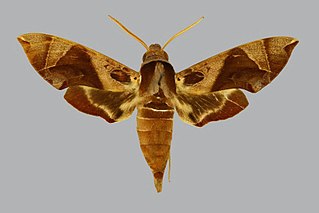
Daphnis layardii is a moth of the family Sphingidae. It was described by Frederic Moore in 1882 and is known from Sri Lanka.
Scopula moorei is a moth of the family Geometridae. It is found in India.
Yirrkala moorei is an eel in the family Ophichthidae. It was described by John E. McCosker in 2006. It is a marine, tropical eel which is known from the western central Pacific Ocean, including Marquesas and American Samoa. It dwells at a depth range of 25 to 454 metres. A juvenile male specimen measured a total length of 43.4 centimetres (17.1 in).
Chilecomadia is a genus of moths in the family Cossidae.
Nossa moorei is a moth in the family Epicopeiidae first described by Henry John Elwes in 1890. It is found in the Indian state of Assam, Bhutan, and China.
Metaperipatus is a genus of velvet worms in the family Peripatopsidae that contains the species Metaperipatus inae. The type locality is in central Chile.













